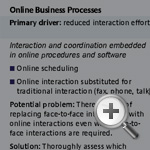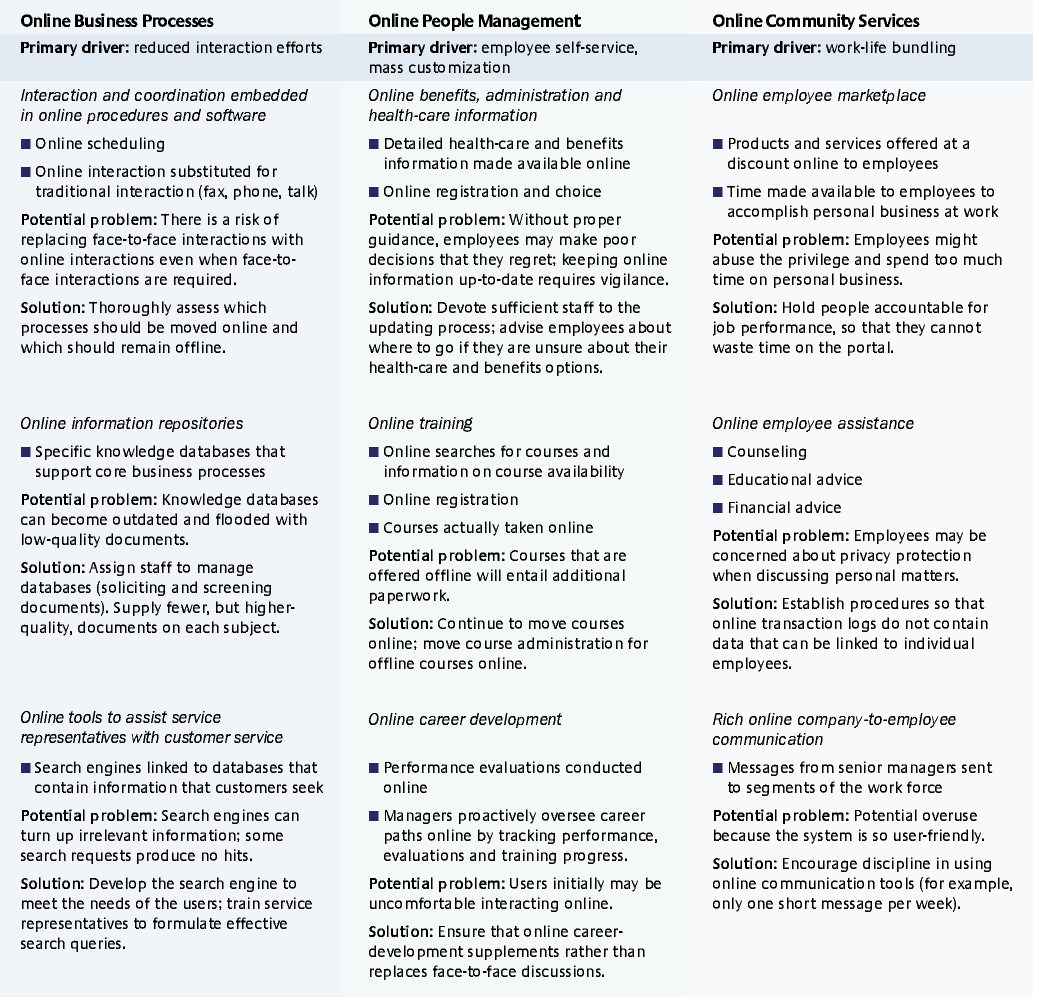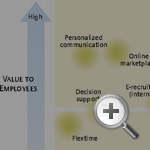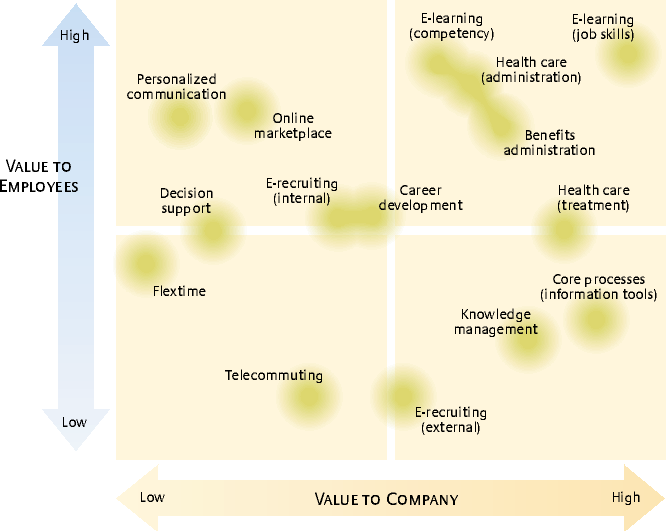Cutting Costs While Improving Morale With B2E Management
Topics
Many companies boast that their employees are their greatest assets, but when the going gets tough, they shed those precious assets in an effort to cut costs and boost efficiency and productivity. But what if you could reduce your costs and cultivate your employees at the same time? The Internet, which has revolutionized value-chain management with business-to-business (B2B) efforts — and retail with business-to-customer (B2C) efforts — makes it possible to do just that.
Business-to-employee (B2E) management lets companies satisfy employees’ needs while streamlining formerly time- and labor-intensive processes. By reducing organizational barriers, B2E enables people to interact more along lines of work than along lines of command. Companies as diverse as Charles Schwab & Co., Cisco Systems, Coca-Cola Co. and Delta Air Lines are setting up B2E systems that emulate B2C models and treat employees like customers. Although the verdict is still out on the long-term benefits of the approach, our research effort over the past year (including 30 interviews at companies doing something innovative in B2E and — for a better understanding of existing B2E technologies — 25 interviews with employees at software and service vendors) shows that early reactions are positive. In one Fortune 100 company we studied, executives calculated that for an initial two-year investment of $8 million, they can achieve annual cost savings of $75 million and an estimated productivity gain of 2% over the next five years. But as that company has found, the real promise of B2E lies in its ability to transform work.
A comprehensive B2E program has three components: online business processes, online people management and online services to the workplace community. (See “The Three Facets of B2E Management.”) The mode of delivery is the integrated enterprise portal. An enterprise portal gives employees one place from which to obtain not only information, but also services. It can be personalized to take into account what function the employee performs and, hence, what resources he or she needs. Fully automated processes can be conducted through the portal, whether it’s signing up for the company’s 401(k) plan or registering for and taking an online training course.
Unlocking Benefits for Each Facet of B2E Management
Each of the three components of B2E management offers benefits to both employees and the company. The drivers of those benefits are easier interactions and more employee self-service, mass customization and work-life bundling (blending work life and personal life). In general, a reduction in interaction efforts has the most influence on the business-process component; self-service and mass customization affect the people-management component; and work-life bundling affects the community-services component.
Improving Business Processes
Just as B2B and B2C Internet businesses reduce the transaction costs between sellers and buyers in external markets, B2E applications reduce the cost and effort associated with employees’ interactions and information searches.
Consider how Delta Air Lines improved processes for the maintenance engineers who service aircraft engines. Because of a constant backlog of engines awaiting service, the time spent servicing an engine is a critical determinant of Delta’s costs: If engines are moved through faster, more aircraft become available, and greater numbers of flights can be scheduled. The problem has been that Delta’s engineers historically have spent too much time on such tasks as searching for information in aircraft-maintenance manuals and identifying the correct spare parts in catalogs. With an online manual and catalog system available through the portal, search time has been cut by 50%, resulting in faster repair time, reduction in engine throughput time and more-productive (and less frustrated) employees.
Delta also is improving its crew-scheduling processes using online technology. Flight attendants and pilots now go online to receive scheduling information and to bid for their shifts. Planned enhancements include the ability to use online tools to adjust schedules instantly in order to accommodate unforeseen openings (for example, in the case of illnesses) as well as to communicate flight status to the crew in real time. The technology will allow Delta to reduce its costs by doing a better job of matching available crew with flight demands.
Online information sources also can make customer service more efficient. In Charles Schwab’s five call centers and more than 400 branch offices, thousands of brokers and service representatives interact with customers, whose numerous and varied inquiries are often hard for even the most seasoned employee to answer quickly. To address that challenge, Charles Schwab executives developed a Web-based information tool called IWIN (“I Want Information Now!”), which comes with a powerful search engine that employees use to answer customers’ questions more quickly and accurately.
The benefits for both employees and companies that such online tools provide are obvious: Having information tools available on the company portal makes employees’ jobs easier and less stressful by reducing interaction time and effort. Because they spend less time searching for information, they are able to accomplish more, and productivity rises. From the company’s perspective, not only are employees more efficient at getting work done, their efficiency reduces delays in core processes. Thus, when the Delta engineers were spending time searching for information, they created a bottleneck in the process of outfitting aircraft with engines, which created delays in other activities. The online-information system struck at the heart of the problem and replaced the negative ripple effect with a positive one.
Improving People Management
B2E also gives greater freedom to employees through self-service and mass customization. Self-managed training is one example of self-service. At Charles Schwab, employees can go to the corporate portal, look up various training courses they think they need, and choose and enroll in them online. In addition, managers can look up a direct report, identify courses he or she has already taken, and enroll the person in an appropriate follow-up class. Employees may take self-paced, online courses whenever they want; for offline classes, they can discover when a class becomes full and when it will next be available. The system is so user-friendly that about 16,000 of Charles Schwab’s 20,000 employees already take advantage of it.
Cisco, too, has self-service. New employees use Cisco’s portal to order office equipment and a mobile phone, choose and enroll in a health-care program, and select and enroll in a benefits program. Those and other introductory activities typically take a week in many companies. At Cisco, they are completed in one day.
But how do such systems deal with the offbeat question, and what about the employee who wants to talk with a real person? At Delta, which tested online benefits enrollment in 2000, experts were available to deal with the complicated questions. And although the company initially worried that employees who were not technologically savvy wouldn’t use the system, its concerns were unfounded: Before Delta’s online benefits-enrollment system had completed the testing stage, 30% of employees had already signed up to use it. As with ATMs, convenience apparently trumps technophobia.
Both employees and the organization benefit from online self-service. Employees find dealing with human-resources matters online less stressful and bureaucratic than handling them in person. Companies appreciate the productivity and cost benefits of employees spending less time on internal administrative tasks — and more time on their actual work. Overhead is reduced because companies need fewer staffers handling calls and processing paper; the company also saves on indirect costs from travel, lodging, and mailing and printing, many of which are expenses that can be eliminated.
Mass customization is the second driver of improved people management. Just as B2C enabled companies to mass-customize relations with customers, B2E allows companies to mass-customize relations with employees. Consider health-care benefits. For years, companies have been offering cafeteria-style benefit plans both to save money and to be more responsive to individuals’ needs. But the plans’ complexity makes them more expensive to administer; the expense, in turn, limits the degree of customization companies can offer. Furthermore, employees find it difficult to navigate through all the choices.
Moving health-care tools online reduces the cost of administering the programs, enabling companies to offer increased customization and making it easier for employees to choose plans that suit their needs. Ford Motor Co., for example, has incorporated an online health-care site called Optate into its portal. At Optate, employees choose the appropriate health plan for their personal circumstances by using a customized comparison of alternative plans. They also can research medical information, locate the closest in-network health-care provider, and choose doctors and hospitals on the basis of quality ratings.
Such a system helps employees by making it easier to choose the most suitable benefits and providers. The company reduces its costs because it is able to negotiate better deals with HMOs and health-insurance providers. It can show that employees who tailor their health-care packages represent less cost to the health plan.
Improving Services to the Workplace Community
Although it appears counterintuitive, some companies also are benefiting from letting employees handle certain personal tasks at work. Coca-Cola, which has one of the most advanced corporate online marketplaces, began negotiating deals with vendors about two years ago to be able to offer its 9,000 U.S. employees preferential deals, including discounts on dry cleaning, restaurant meals and life insurance. All those perks, plus such services as assistance with financial planning, are now available in one place — the company’s portal. The program is immensely popular with employees, who have been increasing their purchases on the site over time. And since employees must meet stringent work objectives, managers are confident that there will be no widespread abuse of the system.
The benefits for employees are attractive: By bundling the electronic activities of their home and work life, all of which they handle at work, they are freed from having to deal with certain chores at home. In addition, by using the corporate portal, they get preferential access to discount deals and services. Companies benefit because employees who are allowed to handle some of their personal business at work are more satisfied with their employer and more committed. They are, in fact, likely to do better work, as many executives have found.
Taking the Online Store as a Model
Although the benefits of B2E management are substantial, designing a successful enterprise portal is difficult. One effective strategy is to treat the portal as an online store that must appeal to a demanding clientele: the company’s employees.
That is what air carrier Swissair did when it wanted to increase employees’ use of Ariba Buyer, a procurement software package that Swissair bought in 1998. Swissair executives reasoned that the system would cut costs by reducing the need for purchasing-department personnel and would ensure higher compliance with contracts. But two years after implementation, barely 20% of Swissair employees were actually using the system. Interviews revealed that employees did not perceive much personal value from learning to use the new tool. They preferred familiar routines. Swissair’s managers decided to leverage the company’s popular portal-based communication tool, which employees rely on as their primary source of up-to-date information about the organization. Managers placed Ariba Buyer near the corporate-communication tool on the portal so that employees could not avoid seeing it. Sure enough, use of the procurement application jumped. In the first month, adoption rose to 30%, and it has been growing steadily ever since.
The first step, then, in designing a successful portal is to make it appealing to users by having the right services and tools available through it. That will draw employees to the portal and get them to use it on a regular basis. Then the company can add features that it wants the employees to use. Put another way, managers must devise an attention-grabbing strategy to generate traffic to the portal and thereby create momentum for B2E applications. It’s an old story: Once the business grabs customers’ attention, it is more likely to sell them products.
One way to grab employees’ attention is to identify and launch “killer applications” for each employee segment to drive traffic to the company portal. Here we use the term for an online tool or service employees find so valuable that they feel compelled to go to the portal to use it — frequently. The importance of leading with an attention-grabbing B2E application implies that the sequencing of B2E initiatives is crucial. Managers therefore need to view the various B2E tools and services as part of a holistic B2E management program.
Consider the approach taken by one company that we helped develop such a program. Managers first surveyed employees, asking them what tools and services they wanted to see online for both personal needs and work purposes. With that data, they rank-ordered the various B2E tools and services. They then estimated the costs and savings associated with each. Armed with the data, the managers then plotted the tools and services on a chart to identify whether any of those that employees wanted also provided high value for the company. (See “How One Company’s Benefits and Employees’ Desires Meet.”) E-learning and online health-care programs met that standard. The managers then moved to tools and services that employees wanted but that were not of high value for the company. An online marketplace was in that category. The rationale for the prioritizing was that getting employees to use the company portal required catering to their needs first. Last came the tools and services that had a high perceived value for the company but not for employees (for example, certain knowledge-management systems).
Is B2E for Everyone?
Simply to say that designing a successful enterprise portal is difficult overlooks who is going to design it, where its tools and services will come from, and how much creating it will cost. Gartner, an IT-consulting company based in Stamford, Connecticut, estimated in 1999 that an enterprise portal featuring full workplace integration would cost between $1 million and $3 million. For companies that can afford the tab, the next question is Who will build it? Of the companies we researched, only Cisco built theirs in-house; the rest relied on outside vendors.
After considering the cost and the expertise issues, however, managers should remind themselves of what B2E management offers. Its real promise is not marginal cost reductions and small productivity gains, but having a digital way of operating and working that emphasizes both productivity and people.




